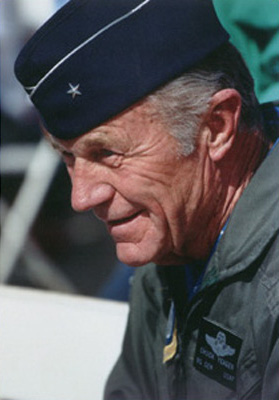 On this date 64 years ago, U.S. Air Force Captain Charles E. “Chuck” Yeager broke the sound barrier in the bullet-shaped Bell X-1 rocket-plane, a pivotal moment in aerospace history. Thanks to Capt. Yeager, on that day the gap between fact and science fiction became a lot smaller.
On this date 64 years ago, U.S. Air Force Captain Charles E. “Chuck” Yeager broke the sound barrier in the bullet-shaped Bell X-1 rocket-plane, a pivotal moment in aerospace history. Thanks to Capt. Yeager, on that day the gap between fact and science fiction became a lot smaller.
For those who only know about the flight through The Right Stuff, the event might not seem like such a big deal. But in many ways, the moment embodied the spirit of exploration and discovery that was at the heart of many golden-age science fiction stories. It represented the cutting edge of engineering and scientific knowledge. It required people to design a vehicle that would operate in an unknown — and perhaps unexplainable — environment. It required a courageous pilot who was willing to take a chance and rely on his skills and wits to see him through. Space heroes from Commander J.J. Adams to Captain James T. Kirk to Space Repairman Clarence “Chuck” Banner (who chose his nickname to honor Capt. Yeager) all pay homage to the original space hero.
 And while we traditionally celebrate the event as a great American moment, we should remember it was also the direct result of the hard theoretical and practical work of many engineers and scientists from around the world. After all, Ernst Mach, the scientist whose pioneering research into fluid dynamics led to the airspeed numbering system that bears his name, was Austrian. Capt. Yeager and the Bell designers stood on the shoulders of giants — and they’d be the first ones to tell you so.
And while we traditionally celebrate the event as a great American moment, we should remember it was also the direct result of the hard theoretical and practical work of many engineers and scientists from around the world. After all, Ernst Mach, the scientist whose pioneering research into fluid dynamics led to the airspeed numbering system that bears his name, was Austrian. Capt. Yeager and the Bell designers stood on the shoulders of giants — and they’d be the first ones to tell you so.
In addition to proving that brightly-colored teardrop-shaped rocketships could indeed fly, the X-1 also contributed to science fiction in a lesser-known and -appreciated way. The plane’s XLR-11 rocket engines were pressurized by steam-driven turbopumps, thereby establishing the importance of steam power in high technology — as anyone who’s ever watched Aliens or the rebooted Battlestar Galactica will appreciate.
As we celebrate this momentous anniversary, I leave you with this thought: is it a coincidence that a mere four months before Capt. Yeager made his historic flight, another pilot — one Kenneth Arnold, flying near Mount Rainier in Washington — ushered in the era of the flying saucers? Perhaps the X-1 was really a prototype flying saucer interceptor, and the real story is that Capt. Yeager secretly led a squadron of rocket aces to do battle with dastardly invaders from distant space over the high desert of California, thereby saving the Earth from invasion . . .
And speaking of anniversaries, this is post #100 on Channel 37! Onward and upward!


Where’s the champagne?
I lift my virtual glass to you! Cheers and congratulations!
The era of flying saucers always reminds of the airship hysteria of 1896-1897, or the German airbase in Montana during World War I.
Ah, yes — the great Mystery Airships. I love those stories, especially the one about the the farmer who claimed he saw an airship rustle one of his cows by lowering a rope and hauling it up into the air. (The earliest “cattle mutilation” story?) FYI, the best repository of mystery airship accounts that I’ve come across on the web is at Airminded.
People thought the Germans had set up an airbase in Montana during WWI? Now that sounds like a cool story. Do tell!